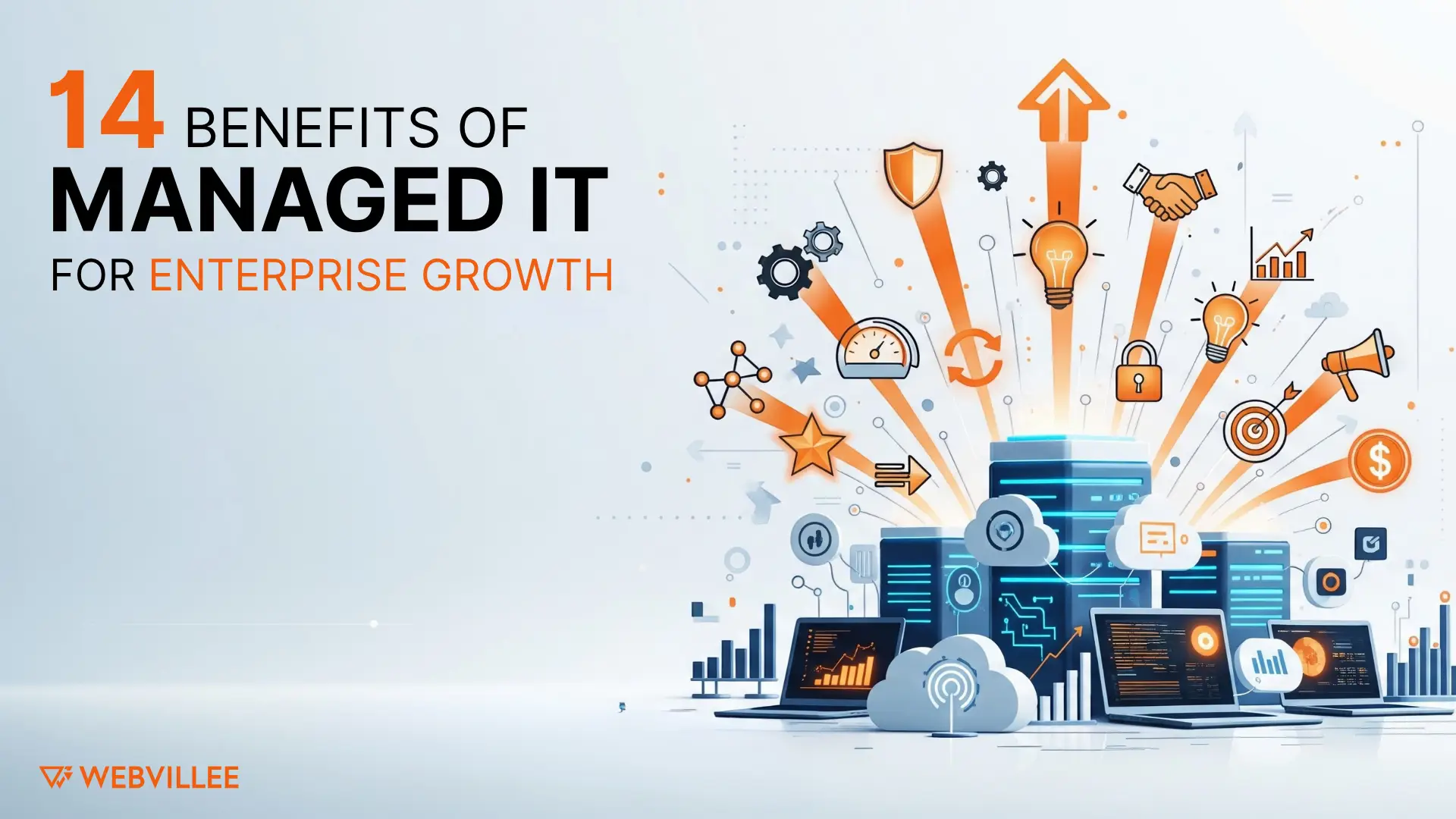The benefits of managed IT services for enterprise growth include lowering costs, improving security, and providing scalability for long-term success.
Outsourcing IT management has become essential for modern enterprises. Maintaining in-house IT teams is expensive, resource-heavy, and often difficult to scale. Managed IT services offer a cost-effective alternative that combines specialized expertise, proactive monitoring, and flexible support. This allows businesses to focus on their core operations instead of troubleshooting technical problems.
Enterprises also face rising security threats and regulatory demands. Managed IT services address these challenges by delivering round-the-clock protection, compliance support, and disaster recovery solutions. For business leaders, this means peace of mind and a clear path toward efficiency.
In this blog, we will explore 14 practical benefits that managed IT services deliver. Each section outlines how outsourcing IT enables enterprises to reduce risks, boost efficiency, and sustain growth while keeping costs under control.
How do Managed IT Services reduce operational costs?
Managed IT services reduce operational costs by eliminating the overheads of in-house IT teams and preventing costly downtime.
Enterprises often spend heavily on salaries, training, and infrastructure for internal IT departments. Outsourcing shifts these expenses to a service provider who delivers the same or better support at a fraction of the cost. This approach ensures businesses only pay for the services they need, optimizing their IT budget.
Ways managed IT cost savings are achieved:
- Reduced need for full-time IT staff and training.
- Lower infrastructure costs for hardware and software.
- Proactive maintenance that prevents expensive downtime.
For example, an enterprise with distributed teams may face high costs maintaining servers and networks across locations. With Managed IT Services, support is centralized, efficient, and predictable.
Operational cost reduction goes beyond short-term savings. It creates financial stability by allowing leaders to allocate funds toward innovation and expansion. In 2025, cost efficiency remains one of the strongest reasons enterprises outsource IT management.
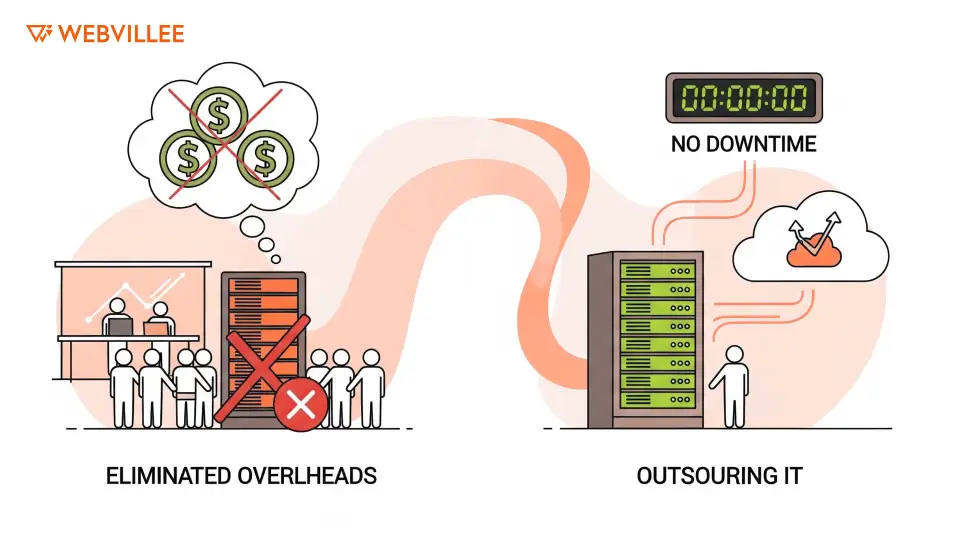
How do Managed IT Services improve security?
Managed IT services improve security through continuous monitoring, advanced threat detection, and compliance-driven practices.
Cybersecurity risks are increasing, and enterprises face constant threats from phishing, ransomware, and data breaches. In-house teams often lack the resources to monitor systems 24/7. Service providers deliver enterprise-level threat detection that protects sensitive data and reduces risks.
Key IT security benefits of managed services:
- Proactive detection of suspicious activity.
- Regular updates and patch management to prevent vulnerabilities.
- Compliance with industry regulations for data protection.
For instance, a financial services company may rely on Cloud Solution tools within managed IT to secure customer transactions while maintaining compliance standards.
By outsourcing to experts, enterprises gain stronger protection without investing heavily in specialized internal teams. In 2025, managed cybersecurity services are no longer optional, they are critical to sustaining enterprise growth and maintaining customer trust.
Why do Managed IT Services increase efficiency?
Managed IT services increase efficiency by streamlining IT operations, automating processes, and freeing employees to focus on core work.
When internal teams spend time fixing technical issues, productivity suffers. Managed providers handle these routine tasks, ensuring systems run smoothly without interruptions. This creates space for employees to focus on business-critical objectives instead of troubleshooting.
Ways IT efficiency is improved:
- Automated monitoring to detect and resolve issues quickly.
- Optimized workflows that reduce downtime.
- Access to advanced tools without complex setup.
For example, enterprises adopting Product Engineering support through managed IT gain customized solutions that improve operational efficiency. Teams no longer waste time managing outdated software or fragmented systems.
The outcome is higher productivity across departments. Employees stay focused, operations run smoothly, and leadership can direct resources toward innovation. In 2025, efficiency is a top driver for outsourcing IT services.
How do Managed IT Services provide scalability?
Managed IT services provide scalability by offering flexible service models that grow with the enterprise.
Traditional IT setups often require heavy upfront investments in hardware and staff. Managed services replace this with adaptable solutions that scale up or down based on business demand. This means enterprises avoid overpaying for unused capacity while staying prepared for rapid growth.
Scalable IT services offer:
- Flexible infrastructure that expands as business needs evolve.
- On-demand access to resources without long procurement cycles.
- Cost control by paying only for required services.
For example, a company expanding into new regions can quickly scale its systems without large infrastructure costs. By linking with Digital Transformation, scalability ensures IT aligns with broader growth strategies.
In 2025, scalability is not optional, it is a vital feature that makes IT support agile, cost-effective, and responsive to changing enterprise needs.
How do Managed IT Services ensure business continuity?
Managed IT services ensure business continuity through disaster recovery and backup solutions that keep operations running.
Unexpected disruptions such as system failures, cyberattacks, or natural disasters can halt productivity. Without safeguards, enterprises face lost revenue and reputational damage. Managed providers build continuity plans that restore systems quickly and minimize downtime.
Business continuity services include:
- Automated backups of critical data.
- Disaster recovery solutions to restore operations.
- Ongoing system monitoring to prevent failures.
For instance, an enterprise struck by a network outage can recover within hours if backups and recovery plans are in place. Without managed services, the same outage might take days to fix.
In 2025, IT backup benefits ensure enterprises stay resilient. Business continuity is no longer just about protecting systems, it is about protecting trust, revenue, and long-term growth.
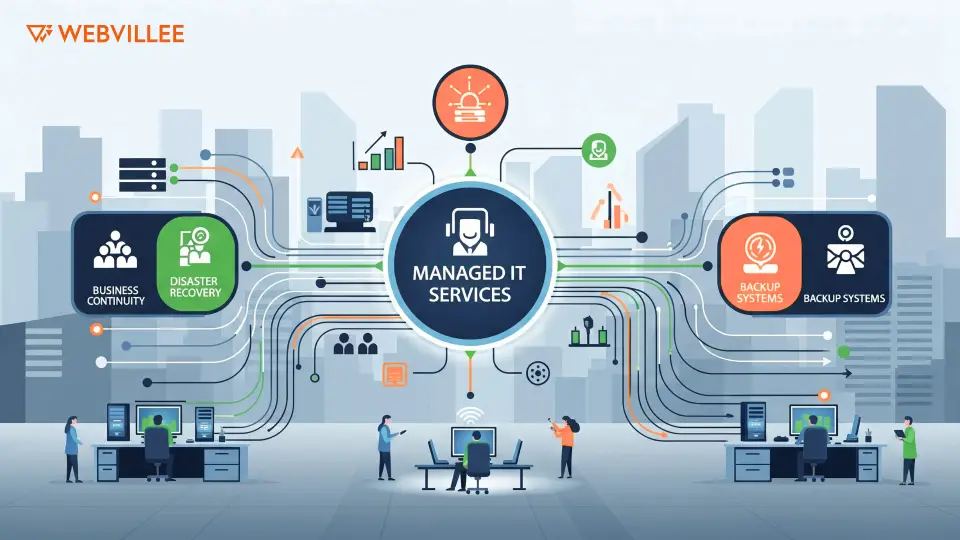
Why do Managed IT Services support compliance?
Managed IT services support compliance by embedding governance, monitoring, and reporting tools into enterprise operations.
Enterprises must comply with strict regulations covering data privacy, financial reporting, and industry standards. Failure to do so results in penalties and reputational damage. Managed providers ensure compliance is maintained across all IT systems.
IT compliance services deliver:
- Regular audits to ensure adherence to regulations.
- Secure data governance practices.
- Automated reporting for regulators and stakeholders.
For example, a healthcare provider must comply with patient data laws. With Service Now support integrated into managed services, compliance monitoring becomes seamless and reliable.
By outsourcing compliance oversight, enterprises reduce risks while freeing internal teams from manual reporting. In 2025, compliance-driven IT management is essential for trust, risk reduction, and enterprise growth.
How do Managed IT Services provide access to expertise?
Managed IT services provide access to expertise by offering specialized skills without the cost of hiring full-time staff.
IT demands are diverse, covering cybersecurity, cloud, networking, and software integration. Maintaining in-house specialists for every area is expensive and often unrealistic. Managed providers deliver access to experts across multiple domains.
Benefits of IT expertise on demand include:
- Access to certified professionals.
- Faster problem resolution.
- Reduced costs compared to building large internal teams.
For instance, an enterprise struggling with advanced cybersecurity threats can instantly tap into experienced professionals through managed IT services. This prevents delays and protects business continuity.
In 2025, outsourced IT specialists allow businesses to operate with confidence. Expertise becomes a service, giving enterprises world-class support without long recruitment cycles or overhead costs.
How do Managed IT Services improve technology integration?
Managed IT services improve technology integration by unifying existing tools and platforms.
Enterprises often operate with disconnected systems, which create inefficiencies and errors. Managed providers integrate platforms so data flows seamlessly across departments.
Examples of integrated IT platforms include:
- Linking CRM to ERP systems.
- Connecting cloud apps with internal databases.
- Reducing silos by consolidating IT tools.
For example, when customer service teams access real-time updates from ERP, response times improve. By leveraging CRM & ERP integration, enterprises achieve operational efficiency and eliminate duplication.
In 2025, reducing IT silos is critical. Integrated systems deliver accuracy, speed, and cost savings that support enterprise growth.
How do Managed IT Services support proactive monitoring?
Managed IT services support proactive monitoring by detecting and resolving issues before they disrupt operations.
Reactive IT support often means fixing problems after damage is done. Proactive monitoring flips this approach by identifying risks early.
Key benefits of proactive IT monitoring include:
- 24/7 system oversight.
- Alerts for unusual activity.
- Prevention of downtime through early fixes.
For example, an enterprise may avoid a costly outage when its provider detects unusual server behavior and resolves the issue immediately.
In 2025, IT issue prevention is more valuable than response. Proactive monitoring ensures business continuity, minimizes costs, and sustains customer trust.
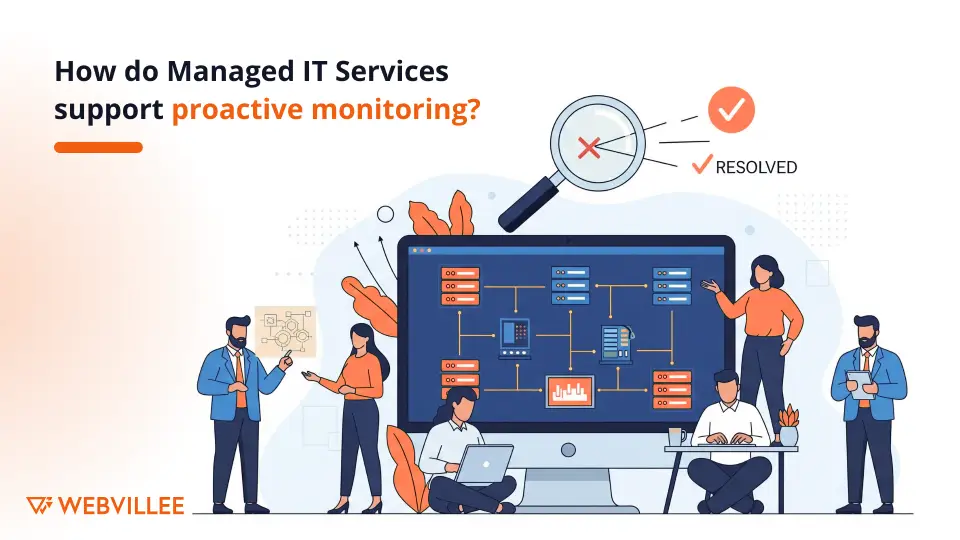
Why do Managed IT Services help startups and SMEs grow?
Managed IT services help startups and SMEs grow by delivering enterprise-level IT infrastructure at affordable rates.
Small businesses often lack the resources to build advanced IT teams or infrastructure. Managed services bridge this gap, giving them access to tools that drive growth.
Ways SMEs benefit from managed IT services:
- Affordable access to enterprise-grade IT.
- Scalable systems that grow with the business.
- Reduced risks with professional monitoring.
For example, a startup launching a new product can scale its IT systems quickly with managed services instead of spending heavily on internal IT.
In 2025, managed IT for startups is a growth accelerator. SMEs compete on equal terms with larger players by accessing infrastructure and expertise that would otherwise be out of reach.
How do Managed IT Services enhance customer experiences?
Managed IT services enhance customer experiences by ensuring systems are stable, secure, and reliable.
Customers expect fast responses and consistent service. Downtime, data breaches, or slow systems damage trust. Managed providers maintain reliable IT environments that support customer satisfaction.
Customer experience IT benefits include:
- Faster response times with stable platforms.
- Secure transactions that build trust.
- Consistent availability of digital services.
For example, an e-commerce company supported by managed IT services can deliver uninterrupted shopping experiences, even during peak demand.
In 2025, customer experience is directly tied to IT reliability. Enterprises that invest in managed IT see stronger loyalty, higher satisfaction, and greater long-term growth.
How do Managed IT Services free leadership to focus on growth?
Managed IT services free leadership to focus on growth by reducing distractions from day-to-day IT problems.
Executives often lose time addressing technology issues instead of strategy. Outsourcing ensures IT is handled by specialists, giving leaders more capacity to plan and innovate.
Leadership benefits of IT outsourcing include:
- Reduced IT distractions for CEOs and managers.
- More time for strategic initiatives.
- Greater confidence in system reliability.
For example, a COO managing frequent outages can focus on operational improvements when IT stability is guaranteed.
In 2025, IT outsourcing benefits for CEOs and leaders are clear: fewer interruptions, stronger focus on innovation, and greater capacity for enterprise expansion.
How do Managed IT Services reduce risks of downtime?
Managed IT services reduce downtime risks through proactive support and 24/7 monitoring.
Downtime leads to lost revenue, reputational damage, and reduced customer trust. By continuously monitoring systems, providers detect and resolve issues before they escalate.
Ways downtime is reduced:
- Proactive detection of server or network problems.
- Immediate response with round-the-clock support.
- Regular system maintenance to prevent failures.
For instance, enterprises using Simplified IoT Solutions within managed IT can monitor connected devices and prevent disruptions.
In 2025, downtime prevention is a critical driver of growth. Managed IT keeps enterprises reliable, ensuring continuity and customer trust.
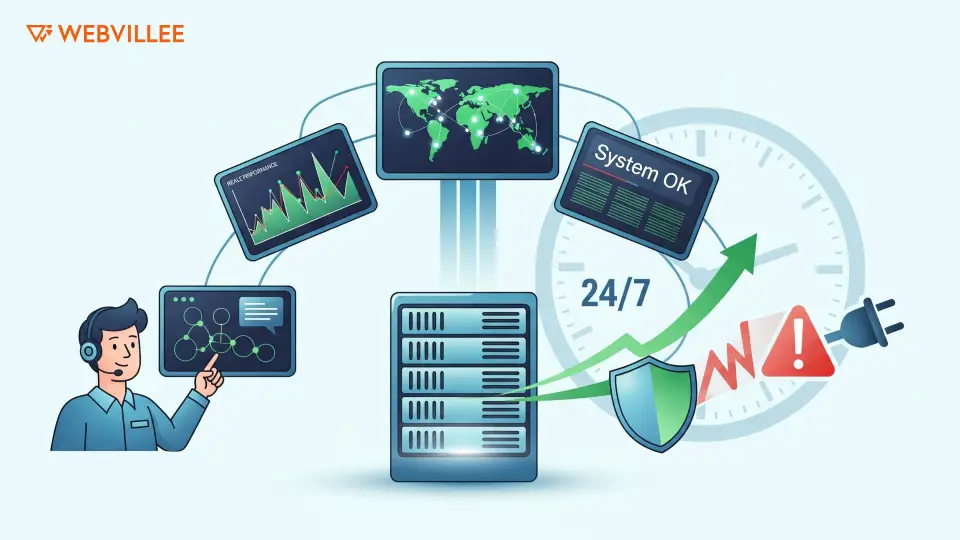
How do Managed IT Services future-proof enterprises?
Managed IT services future-proof enterprises by keeping systems updated with the latest tools and practices.
Technology evolves quickly, and outdated systems create risks. Managed providers continuously update infrastructure and adopt new solutions, ensuring enterprises remain competitive.
Future-proof IT strategies include:
- Regular upgrades to software and security protocols.
- Adoption of best practices in IT modernization.
- Guidance on emerging technologies.
For example, an enterprise supported by managed IT services can integrate new cloud applications seamlessly without large upfront costs.
In 2025, IT modernization is not just about keeping pace, it is about preparing for long-term growth. Future-proofing ensures enterprises remain resilient and adaptable.
What do these benefits mean for enterprise growth?
The benefits of managed IT services for enterprise growth are clear: cost savings, stronger security, greater efficiency, compliance, and scalability.
By outsourcing IT, enterprises gain expertise, reduce risks, and focus leadership attention on strategy instead of troubleshooting. Customers benefit from reliable systems, while businesses save money and prepare for long-term success.
Managed IT is more than a cost-saving measure. It is a growth enabler that combines proactive monitoring, integration, and modernization to keep enterprises resilient.
For CFOs, CEOs, CMOs, and business owners, the message is simple. Partnering with the right provider ensures IT works as a driver of growth, not a source of setbacks.
Get in touch with Webvillee to explore Managed IT Services tailored to your business growth goals.

